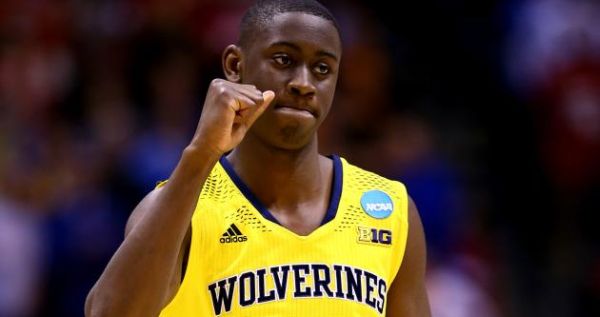Finding Michigan’s Winning Formula In Spite of Frontcourt Troubles
Posted by Patrick Engel on November 30th, 2015Michigan looked like the Michigan of old in a 78-72 win over Texas on Friday night, shooting 58 percent from the floor and scoring 1.26 points per possession. But in both losses to date this season — a loss last Wednesday to Connecticut and a November 20 loss to Xavier — Michigan struggled to rebound, score in the paint or find a reliable scorer outside of do-everything guard Caris LeVert. All of these were familiar struggles for those who watched much of Michigan’s 16-16 season last year. Here’s a closer look at Michigan’s first six games and the best way for the Wolverines to improve some of the maladies that appear to again ail them.

Caris LeVert needs consistency around him for Michigan to win consistently. (Andy Lyons/Getty Images)
Let’s start with the team’s most obvious weakness: Michigan’s frontcourt has simply not been very good. There are several, but the most damning statistic is that no Wolverines’ big man is averaging more than 2.7 rebounds per game. To put this into perspective, Derrick Walton, Jr., Michigan’s 6’1″ point guard, has 14 more rebounds than any post player on the roster. Furthermore, Michigan’s offensive rebounding percentage comes in at just 25.8 percent (256th nationally, per KenPom.com). In the two losses that number was even lower — at 19.4 percent and 23.8 percent, respectively. Meanwhile, the Musketeers and Huskies posted respective offensive rebounding percentages of their own of 45.0 percent and 32.3 percent. The Wolverines had an easier time on the glass in wins against Charlotte, Elon and Northern Michigan, but none of those teams possess the length, size and athleticism that Xavier and Connecticut have; perhaps more importantly, none have the length, size and athleticism that Big Ten opponents will have.
While John Beilein‘s teams perennially use the three-point shot as a potent offensive weapon, this year’s Wolverines have been forced to rely too extensively on three-pointers (45.2% of field goal attempts), many of which are rushed or poorly set up. In the team’s first three wins, Michigan attempted an average of 15 more two-pointers than three-pointers. In the two losses, the Wolverines attempted more three-pointers than two-pointers. In the win over Texas, they shot 25 of each. The three-pointer has been the bread and butter of Beilein’s offense since he took over at Michigan, but as a result of the lack of productivity in the frontcourt, this team has become a little too reliant on it. In Michigan’s nine years under Beilein, only one other team (2008-09) took a greater percentage of its shots from behind the three-point arc. Players other than LeVert shot 6-of-25 from three against Connecticut, and Zak Irvin, who’s still working to get back to full health after his September back surgery, has made only four three-pointers on the year.
Michigan is still a talented team with a very good crop of shooters, but its margin for error is thin because of its lack of frontcourt productivity. Last week’s win over Texas shows that it can beat a team with size when the jump shots are falling, but there may be no true remedy for its issues on the front line. Expect the Wolverines to use plenty of pick-and-rolls to find some scoring in the paint, because Beilein knows they won’t come from a big man with his back to the basket. Either way, one thing remains true in Ann Arbor: Michigan must shoot well from long range to win basketball games.









































